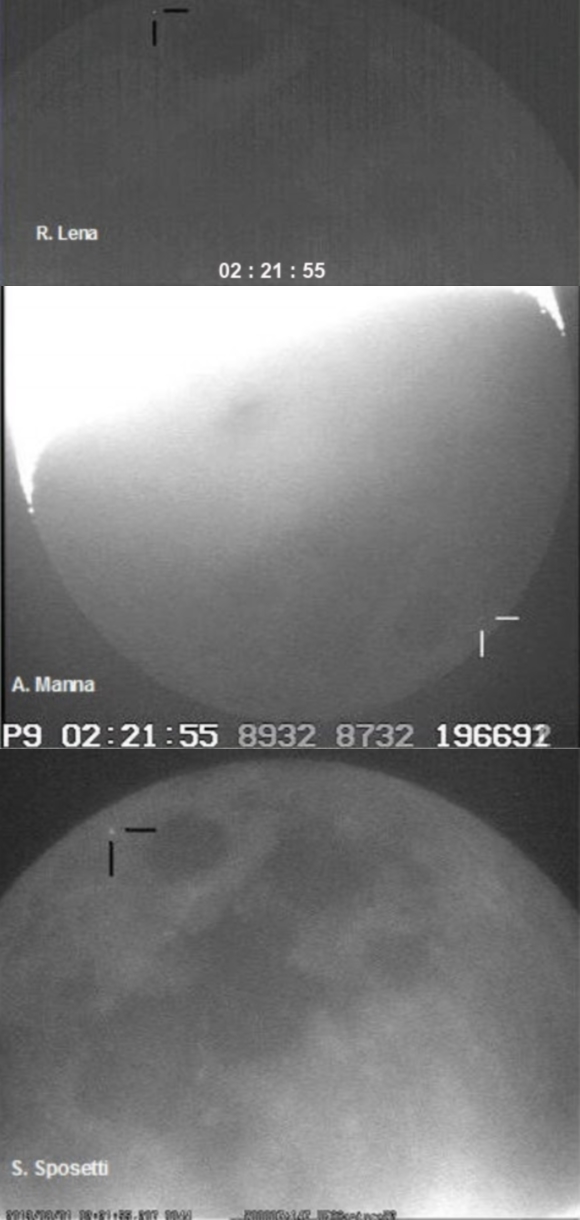Raffaello Lena, of the GLR Group in Rome, has documented the simultaneous observation of the exceedingly transitory flash of an impact on the Moon by three observers, using four telescopes equipped with CCD cameras, from three separate locations.
"On August 1, 2013 at 02:21:55.7 UT, we observed a small meteoroid impact on the Moon's surface. The kinetic energy transformed into heat caused a brief and intense flash detected simultaniously in telescopes operated by R. Lena, A. Manna and S. Sposetti.
"The simultaneity of the flash observations, at the same position on the lunar surface strongly indicate the flash is unlikely to be mistaken for anything other than an impact."
The event was recorded by Raffaello Lena in Rome Italy, Andrea Manna in Cugnasco, Switzerland, and by Stefano Sposetti in Gnosca, Switzerland. The two observatories in Switzerland were separated by 10 km while Lena in Rome was 558 km from Gnosca.
The meteoroidal lunar impact detected on August, 1, 2013 at 02:21:55.7 UT was simultaneously recorded by four independent video recordings. The duration of the flash corresponds with 0.08 seconds peaked in a brightness of 8.3 ± 0.7 magnitude. Synchronicity of the documenting images and related files was verified using GPS time inserters (KIWI-OSD) and an Atomic Clock Synchronization protocol.
The coordinates of the flash were determined to 73° (± 4°) East, 27° (± 3°) North, near the crater Seneca C.
"The flash probably corresponds to an α-Capricornids meteor stream, exhibiting favorable geometry at time of impact."
A report of the coordinated observing session is published in Selenology Today, HERE, and an Adobe pdf file with the particular of the event and observing session can be also downloaded HERE.
In addition, Lena reports, "some animations and data, are also presented on my website: http://lunarimpact2.blogspot.it/ ."
Related Posts:
Earth's Nightlight (June 26, 2013)
March of Time Paces Changes on the Lunar Surface (May 21, 2013)
Brightest impact recorded by NASA lunar monitoring program, March 17 (May 17, 2013)
LROC team identifies a new lunar crater (July 28, 2010)
Lunar meteor impact observations and the flux of kilogram-sized meteoroids (July 25, 2010)
The Lunar Geminids (December 10, 2009)
Impact Gap in the Moon's Southern Highlands? (May 22, 2008)
"On August 1, 2013 at 02:21:55.7 UT, we observed a small meteoroid impact on the Moon's surface. The kinetic energy transformed into heat caused a brief and intense flash detected simultaniously in telescopes operated by R. Lena, A. Manna and S. Sposetti.
"The simultaneity of the flash observations, at the same position on the lunar surface strongly indicate the flash is unlikely to be mistaken for anything other than an impact."
The event was recorded by Raffaello Lena in Rome Italy, Andrea Manna in Cugnasco, Switzerland, and by Stefano Sposetti in Gnosca, Switzerland. The two observatories in Switzerland were separated by 10 km while Lena in Rome was 558 km from Gnosca.
The meteoroidal lunar impact detected on August, 1, 2013 at 02:21:55.7 UT was simultaneously recorded by four independent video recordings. The duration of the flash corresponds with 0.08 seconds peaked in a brightness of 8.3 ± 0.7 magnitude. Synchronicity of the documenting images and related files was verified using GPS time inserters (KIWI-OSD) and an Atomic Clock Synchronization protocol.
The coordinates of the flash were determined to 73° (± 4°) East, 27° (± 3°) North, near the crater Seneca C.
"The flash probably corresponds to an α-Capricornids meteor stream, exhibiting favorable geometry at time of impact."
A report of the coordinated observing session is published in Selenology Today, HERE, and an Adobe pdf file with the particular of the event and observing session can be also downloaded HERE.
In addition, Lena reports, "some animations and data, are also presented on my website: http://lunarimpact2.blogspot.it/ ."
 |
| The phase of the Moon at the time the impact was observed at three locations on Earth, 0221.55 UT, August 1, still a considerably bright 29.7 percent illumination from a Moon, 23.63 Earth-days old in the early predawn. At time of impact, still late July 31 in North America, the Moon was 405,528 km distant [Virtual Moon Atlas v.6]. |
Earth's Nightlight (June 26, 2013)
March of Time Paces Changes on the Lunar Surface (May 21, 2013)
Brightest impact recorded by NASA lunar monitoring program, March 17 (May 17, 2013)
LROC team identifies a new lunar crater (July 28, 2010)
Lunar meteor impact observations and the flux of kilogram-sized meteoroids (July 25, 2010)
The Lunar Geminids (December 10, 2009)
Impact Gap in the Moon's Southern Highlands? (May 22, 2008)


No comments:
Post a Comment